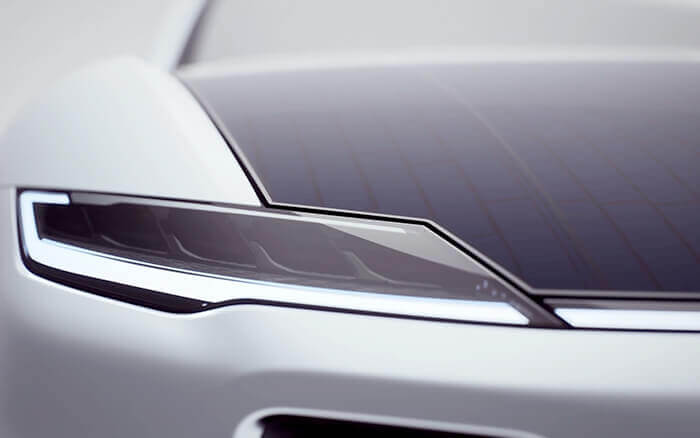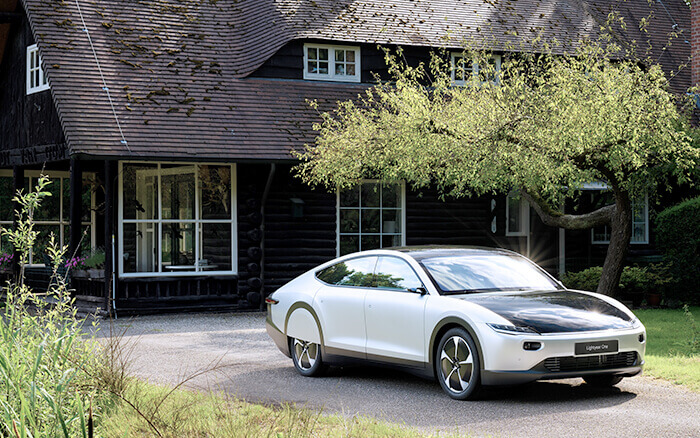
Charging Ahead with Solar
From the sidewalk, you turn and watch it drive by. There it is again. That beautiful, crazy, teardrop-shaped electric car. The one from the future.
At first, you didn’t realise its sleek, double-curved roof and hood were covered with powerful solar cells. But now you know. And it changes everything. From now on, it’s not enough for an electric car to exude power from within. It must also draw power from the sun above.
Lightyear One is the world’s first long-range solar car, powered by five square meters of
SunPower® Maxeon® cell technology.
Driving the Future of Mobility
We tend to think of electric cars as the most energy-efficient of all. But not long ago, the innovators at a startup called Lightyear saw vast room for improvement in the rapidly-growing world of EVs. So they set out to create something remarkable: an electric car that uses energy-efficient design and integrated solar cells to dramatically increase its range between recharges. All with a design aesthetic as clean as the energy it produces. Today, that dream is quickly becoming a reality in the form of Lightyear One, a fully-functioning prototype complete with SunPower® Maxeon® solar cells. Recent testing showed that it can travel up to 725km without a recharge – a distance no other available EV can touch. And with production set to begin in 2021, the Lightyear vision of a more sustainable future for mobility is well within reach.
Lightyear One’s range of up to 725km is the result of a fully-integrated design vision.
Ultra-Efficiency
In the true pioneer spirit, the Lightyear team began by rethinking the concept of a car, pushing aside convention and starting from scratch. Their early decision to focus relentlessly on efficiency made solar technology a critical factor. “The car actually is based on the fact that we had to fit five square metres of solar panels onto it, and all the rest is designed around it,” said Rocco Carrieri, Senior Designer for Lightyear partner Granstudio. Given SunPower’s reputation as a leader in solar efficiency – as well as our long history with record-breaking experimental solar cars – Lightyear chose our Maxeon technology to deliver vast amounts of clean energy in a limited space. It’s an honor to provide the solar capability for this revolutionary automobile, and to see our cell technology sculpted with simple elegance into its breathtaking design.
Advanced Aerodynamics
The less air a car must move, the further it can travel on the same amount of energy. The Lightyear team painstakingly optimized the airflow around and under every part of the vehicle, from chassis to crash zone to wheel bays. Even the exterior mirrors were replaced with sideview cameras. The resulting teardrop body shape is as elegant as it is efficient, and SunPower Maxeon solar cells proved to be the perfect complement. Our innovative copper foundation gives each cell far more strength and flexibility than conventional ones, wrapping beautifully around Lightyear One’s sweeping contours without cracking. And since there are no unsightly metal lines across the front like typical cells, Maxeon technology blends seamlessly with the car’s minimalist styling, while delivering maximum power.
Continuous Charging
The optimised aerodynamics and design of Lightyear One mean that a fully-charged battery has a range of up to 725km – enough to travel from Amsterdam to Paris, and beyond. Thanks in large part to the SunPower solar cells crafted into its bonnet and roof, Lightyear One can charge up to 12km/h as it goes. And since this impressive range extends with every hour of sunlight, solar technology with superior low-light capabilities is critical. Maxeon solar cells are engineered to be highly receptive to the blue light of early morning and cloudy conditions, as well as the red light of evening. By producing power earlier and staying on longer, SunPower technology gives Lightyear One the maximum clean energy possible. And a driving range second to none.
Built to Last
Lightyear One’s integrated solar cells are responsible for powering a significant portion1 The solar roof and hood charge up to 12 km/h in the sun. Your climate and driving frequency will determine the percentage of your mileage the solar can provide, which is up to 100%. Someone driving the national average of 20,000 km/year in the cloudy Netherlands would get about 40% of their mileage from solar energy. (https://lightyear.one/lightyear-one/) of the car’s lifetime mileage, a power and endurance test only SunPower technology can handle. Our Maxeon panels, comprised of Maxeon cells, are ranked #1 for durability2 Jordan, et. al. Robust PV Degradation Methodology and Application. PVSC 2018 in the most challenging conditions, including extreme temperatures, jarring vibrations and high winds. And SunPower sets the standard for reliability, as well; testing shows that a 25-year-old Maxeon panel generates more power than a brand-new conventional panel.3 Compared to a 365W, >21% efficient panel with a 0.25% annual power degradation rate.

SunPower Maxeon technology powers the Lightyear One.
It’s no wonder that the very same solar technology powering Lightyear One has been chosen by countless homeowners and businesses around the world. In fact, our Maxeon solar panels deliver the highest efficiency available today4 Based on datasheet review of websites of top 20 manufacturers per IHS, as of May, 2019. , generating up to 35% more energy from the same space when compared to conventional solar over 25 years.5 SunPower 400 W, 22.6% efficient, compared to a Conventional Panel on same-sized arrays (310 W mono PERC, 19% efficient, approx. 1.64 m²)
Driving Sustainability
By using sustainable materials throughout Lightyear One, and by expecting suppliers to meet proper environmental and ethical standards, the Lightyear team ensures that sustainability is core to its entire process. It’s a commitment we share as a sustainability leader, earning solar’s first and only landfill-free verification from NSF for our Mexicali, Mexico fabrication facility. We were also the first solar panel manufacturer to achieve the prestigious Cradle to Cradle Certified™ designation for our Maxeon DC solar panels.6 All SunPower Maxeon 2 and Maxeon 3 DC panels are Cradle to Cradle Certified™ Silver. Cradle to Cradle Certified products are evaluated for material health, material reutilization, renewable energy use and carbon management, water stewardship, and social fairness. Cradle to Cradle Certified is a certification mark licensed by the Cradle to Cradle Products Innovation Institute.
At SunPower, we applaud the tireless dedication and unbridled optimism of solar pioneers like Lightyear, as they accelerate the transformation to a clean-energy world. And when it comes to their commitment to “getting the most out of every ray of sunshine,” we couldn’t agree more.
Lightyear One: Quick Facts
| Mission: | Making clean mobility available to everyone, everywhere | |
| energy: | Five square metres of SunPower Maxeon cell technology, sculpted into a double-curved roof and bonnet | |
| propulsion: | Independent in-wheel motors replace typical powertrain of combustion vehicles | |
| KErb weight: | 1,300 kg | |
| charging options: | Solar, 230V socket, charging station | |
| sustainability awards: | CES Climate Change Innovator, Postcode Lottery Green Challenge Finalist | |
